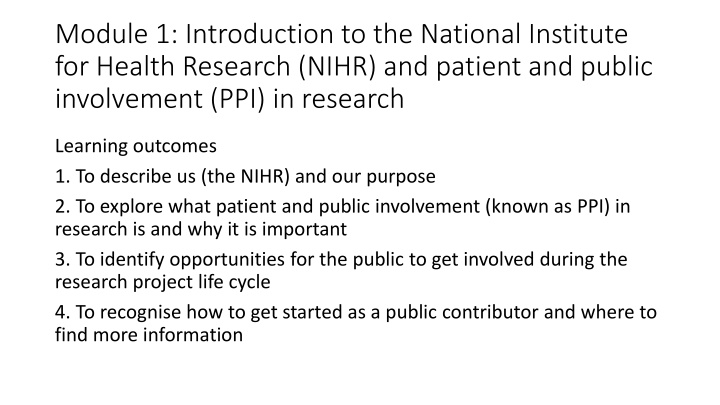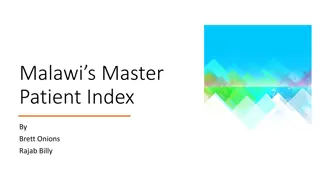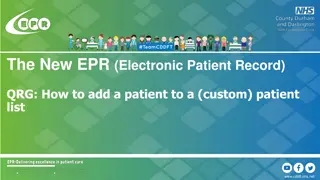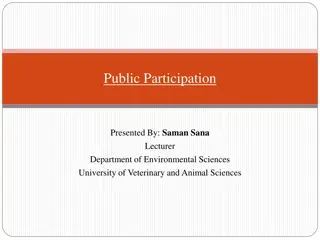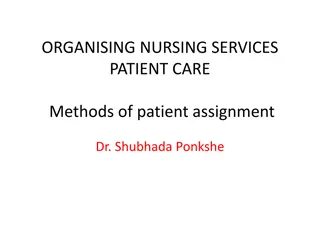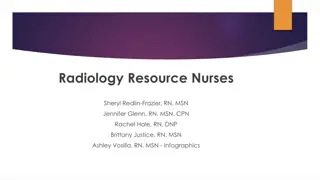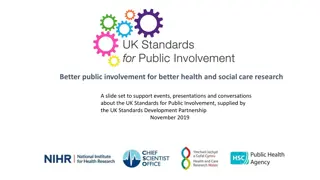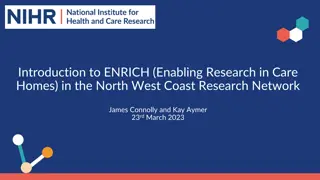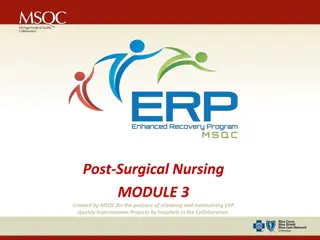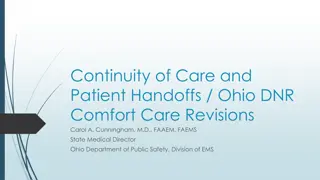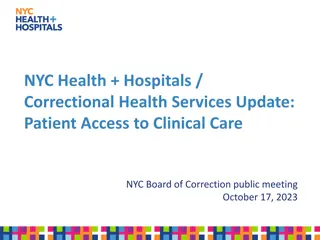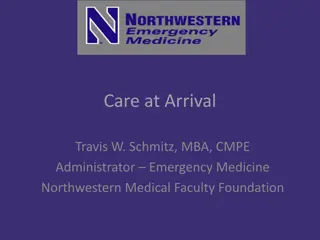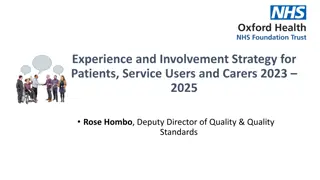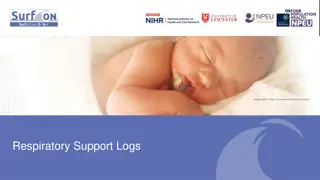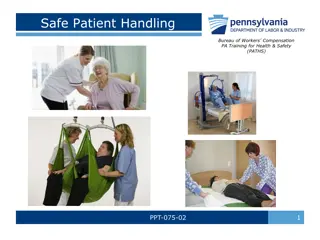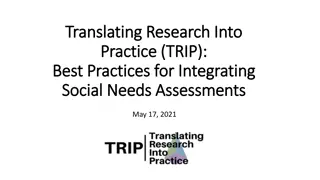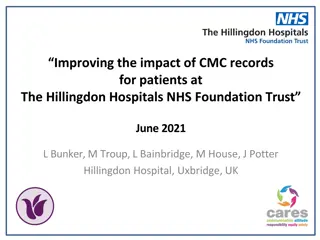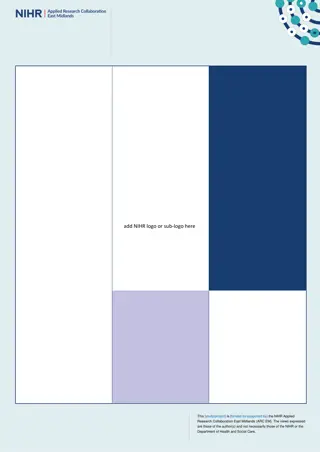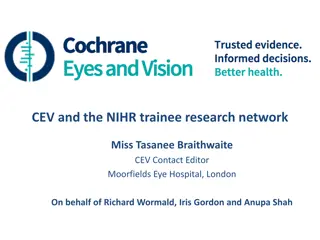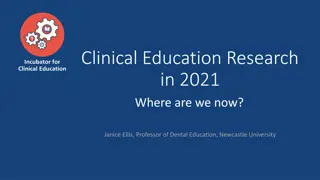Introduction to NIHR and Patient & Public Involvement in Research
Explore the National Institute for Health Research (NIHR) and the significance of Patient and Public Involvement (PPI) in research. Learn about NIHR's role in funding and supporting health and social care research, involving patients and the public, training researchers, and collaborating with stakeholders to advance healthcare. Discover opportunities for public engagement throughout the research project life cycle.
Download Presentation

Please find below an Image/Link to download the presentation.
The content on the website is provided AS IS for your information and personal use only. It may not be sold, licensed, or shared on other websites without obtaining consent from the author.If you encounter any issues during the download, it is possible that the publisher has removed the file from their server.
You are allowed to download the files provided on this website for personal or commercial use, subject to the condition that they are used lawfully. All files are the property of their respective owners.
The content on the website is provided AS IS for your information and personal use only. It may not be sold, licensed, or shared on other websites without obtaining consent from the author.
E N D
Presentation Transcript
Module 1: Introduction to the National Institute for Health Research (NIHR) and patient and public involvement (PPI) in research Learning outcomes 1. To describe us (the NIHR) and our purpose 2. To explore what patient and public involvement (known as PPI) in research is and why it is important 3. To identify opportunities for the public to get involved during the research project life cycle 4. To recognise how to get started as a public contributor and where to find more information
Module 1: Introduction to the NIHR and public involvement in research 1 Us and our purpose 2 What is PPI in research and why is it important? 3 The research project life cycle and opportunities for PPI 4 How to get started
1.1 Welcome to the National Institute for Health Research (known as the NIHR) Watch the following video that introduces the different aspects of our work. https://youtu.be/hJI6BEZy5HM
1.2 About the NIHR We are a government body set up by the UK Department of Health to organise NHS, public health and social care research. In 2018 the Department of Health became the Department of Health and Social Care. Modern health and social care raises lots of questions. We work with patients, carers, healthcare professionals, service providers, care commissioners and pharmaceutical companies to make sure the NHS gets the evidence it needs to guide effective health and social care decision-making.
1.3 What do you do? (1) We fund health and social care research and turn discoveries into practical products, treatments, devices and procedures. We involve patients and the public at every step. We support NHS staff to be involved in research we and others fund.
1.3 What do you do? (2) We train and support researchers to keep the nation at the forefront of international research. We provide world-class research facilities. We work with charities and the life-sciences industry (pharmaceutical companies) so patients get access to breakthrough treatments as soon as possible.
1.4 The NIHR: A wheel with many cogs Think of us as an umbrella organisation under which there are many different parts, in different places, serving different purposes. Click on the different cogs in the diagram below to explore those which are particularly relevant to this course (there are many more!).
1.4 The NIHR: A wheel with many cogs Research Study Support Training Public Involvement Funding Summaries Design Results
1.4 The NIHR: A wheel with many cogs 1. Research design: We support researchers in designing their research at Research Design Services (known as RDS and regionally based). https://www.nihr.ac.uk/explore-nihr/support/research- design-service.htm 2. Research funding: We have research funding programmes which are managed by NIHR funding co-ordinating centres: NIHR Central Commissioning Facility (known as CCF) and NIHR Evaluation, Trials and Studies Co-ordinating Centre (known as NETSCC). Researchers apply to the programmes for funding. https://www.nihr.ac.uk/researchers/apply-for-funding/how-to- apply-for-project-funding/our-funding-programmes.htm
1.4 The NIHR: A wheel with many cogs 3. Research training: We fund the training of new and developing researchers and support staff through the NIHR Academy. https://www.nihr.ac.uk/health-and-care-professionals/ 4. Public involvement: INVOLVE is our national advisory group which supports the public to get actively involved in NHS, public health and social care research. https://www.involve.nihr.ac.uk 5. Research study support: We help researchers set up studies quickly and effectively through the Clinical Research Network (known as the CRN). https://www.nihr.ac.uk/explore-nihr/support/clinical- research-network.htm
1.4 The NIHR: A wheel with many cogs 6. Research summaries: You can register to receive summaries of new research in your area of interest via the NIHR Dissemination Centre - www.dc.nihr.ac.uk 7. Research results: We publish the results of our studies in our NIHR Journals Library, which you can access online - www.journalslibrary.nihr.ac.uk
1.5 Quiz Check what you ve learned so far by answering the following questions. Click Submit to see the suggested answer. a) Who funds the NIHR? The Government, the Department of Health and Social Care b) What does the NIHR do? Funds, supports and shares health and social care research c) What does NIHR stand for? National Institute for Health Research
1.5 Quiz d) List three types of people who contribute to the NIHR. Patients, carers, healthcare professionals, healthcare commissioners, NHS managers, pharmaceutical companies e) Name one part of the NIHR family that helps people develop their research plans and applications. Research Design Service f) Name one part of the NIHR family that helps set up research in the NHS. Clinical Research Network g) How would you find out about NIHR research results? Through registering online for the NIHR dissemination centre, to receive updates or via the NIHR Journals Library.
2.1 Introducing common terms in patient and public involvement in our research Here are two common terms you will hear in this course. Click the text to reveal the definition. PPI This is the abbreviation for Patient and Public Involvement in research. Public contributor We refer to members of the public, including patients, service users and carers who work with us, as public contributors. You may hear the term lay advisor, lay assessor, expert by experience used elsewhere. It is essentially the same.
2.2 Common public contributor roles We look at two common public contributor roles in the course. Click on the text to reveal the definition. Public reviewer or PPI reviewer (also called referee ) - Public contributors who review a research document and provide written feedback. Public or PPI advisory committee member (sometimes called board or panel member) Public contributors who sit on our funding advisory committees. Public members review the research documents to be discussed at the meeting and contribute to decisions about funding by asking questions and making recommendations. Public members have an equal vote on these committees.
2.3 What can patients and the public offer research? Patients, service users, carers and members of the public: improve the quality and relevance of research; make sure research is acceptable and will benefit patients, carers and service users; and support researchers and healthcare professionals to develop and carry out high-quality, well designed research studies. As well as helping to make sure research is acceptable, of high quality and relevant, you also have the right to be involved in decisions about research which is funded by public money.
2.4 The Chief Medical Officer and our founder agrees No matter how complicated the research, or how brilliant the researcher, patients and the public always offer unique, invaluable insights. Their advice when designing, implementing and evaluating research invariably makes studies more effective, more credible and often more cost-effective. Professor Dame Sally Davies
2.5 Why do people get involved in research? The following animation gives an insight into why someone might get involved. http://www.invo.org.uk/thisismystory
2.6 Patient and Public Involvement (PPI) Q: Is PPI in research the same as taking part in a study or listening to a research news item? A: In a nutshell, no. There are three ways in which we refer to working with patients and members of the public in research, as follows.
2.7 Patient and public involvement (PPI) Involvement Participation Engagement Research which is done with or by patients and the public, rather than to, for or about them. It is an active partnership between researchers and patients and the public. Patients and the public are involved in key decisions throughout the research project life cycle. Where people give their informed consent to take part in a research study. For example, take trial drugs, try a new procedure or type of care, fill in questionnaires or be interviewed about their experiences. They are usually called study participants. Where we share information and knowledge about research with the public who we listen to and learn from as part of the process. The public can ask questions and debate results of the research.
2.7 Patient and public involvement (PPI) All three ways of working with patients and the public are important. Involvement adds to and improves research, and research is not possible without people taking part. We all want to hear and debate about research into health and social care which is important to us. Involvement Research which is done with or by patients and the public, rather than to, for or about them. It is an active partnership between researchers and patients and the public. Patients and the public are involved in key decisions throughout the research project life cycle. This course focuses on opportunities to get involved with us. However, many of the principles are the same when working directly with researchers, other research funders, research bodies and charities.
2.8 What do I have to offer research? You bring your point of view as a member of the public, influenced by your knowledge and experience as a patient or carer and as someone who uses (or might use) services. Think about what experiences you have that you can tap into. Think about the issues that patients are concerned about, the issues that you may have dealt with.
2.8 What do I have to offer research? Researchers want to learn from the knowledge you have gained from living with a condition, or through caring for someone with a condition. Your experiences of being on the receiving end of health and social care can affect how future research is carried out which, in the longer term, can help to shape and improve how care is provided.
2.8 What do I have to offer research? Research is a team effort. As well as members of the public and patients, a range of people contribute to developing and carrying out research at various stages, including those with professional expertise (for example, doctors, nurses and service managers) and scientific and research expertise (researchers, statisticians and economists). You bring a crucial viewpoint to the group.
2.8 What do I have to offer research? You may also be an interested member of the public who can bring a valuable, common-sense point of view to the research plans. This is often called acting as a critical friend : a person who asks the difficult questions (and sometimes they can ask the obvious questions that nobody else has asked), but in a supportive and constructive way. You are working in partnership with the researchers.
3. The research project life cycle and opportunities for PPI
3.2 What type of opportunities are there for patients, carers and service users in research? There are many roles and opportunities. You may take part in a study (trying out the new treatment or service). You may advise on the research plans, how the research is managed and how the results are shared (known as dissemination). We will show you some of the roles in more detail as we go through the life cycle of a typical research project. At each stage we will describe the type of activities you might take part in as a public contributor.
3.2 Roles in the research project life cycle Identifying and prioritising research topics Monitoring and evaluating studies Designing research Developing the funding grant proposal Putting research into practice Click on each stage of the research project life cycle, to find out more about the different ways you might get involved in the process Reviewing funding applications Sharing research Making funding decisions Carrying out the research Managing research
Identifying and prioritising research topics - this could include topics never researched before Work with researchers to identify topics for research. Be consulted about research topics and priorities important to you as a service user or carer. You may be asked to review a research or commissioning brief which developed a research topic. Help to guide research priorities as a member of a local user group or organisation. Identify topics for research yourself, based on your experiences of health and social care.
Designing research - how the research is going to be carried out Do you support the research question? Is it relevant? People who have been through a particular experience often know best what is most important to patients or carers. Make sure the research methods proposed are appropriate for patients - you might spot something where you will know straight away that patients are unable to take part because of their condition or the methods suggested. Help to create a recruitment plan and promote the study. How will patients take part and why would they want to? Comment on the proposed patient questionnaires and methods of collecting information. Are the questions appropriate and easy to understand? Would any of the questions upset you? If so, are they likely to upset patients or people taking part in the research?
Developing the funding grant proposal - for example, helping to write the document which will ask for the money to fund the project Help to make sure that the proposed research and methods chosen are ethical will the research respect the dignity, rights, safety and well-being of the people who take part? Suggest and advise where patients or the public could be involved. Comment on the plain English summary: Is it easy to understand? Does it give all the information it needs to? Help identify the appropriate measurement tools to answer the research question. For example, is length of life as important as quality of life with your condition? Raise awareness of likely costs or difficulties in involving the public. Is the bid for funding appropriate? Will people taking part be properly reimbursed?
Reviewing funding applications - taking part in assessing Public reviewers assess how relevant and acceptable research is and assess PPI methods in applications for research funding. Reviews are an important part of how research funding decisions are made. They can: a. influence how research funders make their decisions (your views help the funding advisory committees decide what should be funded, and whether the research proposals need to be changed to better suit patients); b. provide those applying for funding (the researchers) with feedback, including an assessment of the strengths and weaknesses of their research plans; and c. make sure that the proposed research is needed and is important.
Making funding decisions - being a member of an advisory committee which decides which research to fund Help review a group of complex research applications, give feedback to researchers and decide which studies to fund. In some cases, the committee members also interview the people applying for funding (the researchers). Note that we may also refer to funding advisory committees as funding panels or boards. There are usually two or three public members on these advisory committees along with professionals and academics with different areas of expertise.
Managing research - for example, as a member of a steering committee, advisory group or project team Involving members of the public in managing research can help to make sure that: a public point of view is available throughout an individual project; public involvement is properly funded and used; the right support is developed for members of the public involved in the project; advice is available on improving how people taking part in the study are recruited; and you are involved in recruiting staff and researchers for the study.
Carrying out the research You can get involved in a variety of research roles, such as: collecting and reviewing documents; carrying out interviews and running focus groups; developing questionnaires and information documents (sometimes called patient-facing materials); helping the research team to develop research themes from data; and being consulted by the research team to see if you understand and interpret the data in the same way as they do.
Sharing research - for example, helping to tell other people what the results of the project are Advise on different ways of sharing the results. Jointly present findings with the researchers. Write information for local patient groups, hospitals and so on. Help to get findings published on charities and voluntary organisations websites. Help to write or comment on papers and articles for publication. Help the NIHR Dissemination Centre decide which research we should share.
Putting research into practice Help write the document explaining how a new treatment will be delivered to patients. Develop patient information for use within hospitals, doctors surgeries and so on.
Monitoring and evaluating studies for example, has the research project been delivered and managed well? Have you seen any ways in which things could have been done better? Be involved throughout the study and help to deal with issues as they arise. Work with researchers to evaluate the research process. What went well? What could have gone better? Think about your role in the research and what you have learnt.
4.1 How to get started in PPI INVOLVE (funded by and part of us) are your best first stop for all things PPI. For example, they have a booklet on getting started in PPI. INVOLVE are there to support gold standard PPI (the best possible PPI) and to help you make your work really mean something, leading to better and relevant healthcare for all. You can find their details and links to the INVOLVE Starting Out (2017) booklet in Further information at the end of this module. It is also worth exploring the patient and public pages of our website (see Further information ). We have put together a few tips for those new to PPI - please download.
Further information Useful glossaries INVOLVE s jargon buster http://www.invo.org.uk/resource-centre/jargon-buster/ The European Patients Academy glossary https://www.eupati.eu/glossary/ Our PPI webpages https://www.nihr.ac.uk/patients-carers-and-the-public/ INVOLVE http://www.invo.org.uk/ INVOLVE learning and development webpages http://www.invo.org.uk/resource-centre/learning-and-development/ INVOLVE s induction pack for new starters http://www.invo.org.uk/wp- content/uploads/2018/01/Induction-public-v3.pdf INVOLVE s briefing notes on how to involve the public in research http://www.invo.org.uk/resource-centre/resource-for-researchers/
Further information Our mission, governance and contribution to research: https://www.nihr.ac.uk/about-us/our-mission/our-mission-and-strategic- workstreams.htm How we fund research: https://www.nihr.ac.uk/patients-carers-and-the- public/i-want-to-learn-about-research/how-we-fund-research.htm
